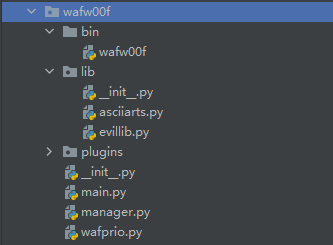
https://github.com/EnableSecurity/wafw00f/
Wafw00f是一款知名的WAF识别工具,目前Github有2300的Star,由Python编写。简单测试了几个网站,发现识别效果不是那么好
整体

- docs:sphinx自动生成文档的工作
- wafw00f:代码
- setup.py:安装脚本
wafw00f

- bin:启动文件,执行这里的脚本即可启动程序
- lib:asciiarts是logo,evillib是发请求的工具类,后续分析
- plugins:指纹识别的规则,后续分析
- main:核心代码
- manager:管理规则的脚本
- wafprio:指纹识别优先级规定
首先看一下plugins目录下的规则文件,每一个都是py文件,并且都有函数is_waf:
def is_waf(self): schemes = [ self.matchHeader(('aeSecure-code', '.+?')), self.matchContent(r'aesecure_denied\.png') ] if any(i for i in schemes): return True return False
比如以上这个规则,是匹配响应头和响应Body中的关键字
正是分析代码,按照一般的规则,先从main.py分析
一开始是常见的参数解析:
parser = OptionParser(usage='%prog url1 [url2 [url3 ... ]]\r\nexample: %prog http://www.victim.org/')
338行print(randomArt())调用asciiarts.py打印LOGO
如果是-l参数那么就打印所有可用的waf,从wafprio文件中读取:
if options.list: ...... try: m = [i.replace(')', '').split(' (') for i in wafdetectionsprio] print(R+' WAF Name'+' '*24+'Manufacturer\n '+'-'*8+' '*24+'-'*12+'\n') max_len = max(len(str(x)) for k in m for x in k) ......
如果是-v参数那么就打印版本信息:
print('[+] The version of WAFW00F you have is %sv%s%s' % (B, __version__, E))
如果有自定义请求头,那么就尝试从指定的文件中解析请求头,getheaders函数较简单
extraheaders = getheaders(options.headers)
如果输入是一个完整的文件,尝试JSON解析:
with open(options.input) as f: try: urls = json.loads(f.read()) except json.decoder.JSONDecodeError: log.critical("JSON file %s did not contain well-formed JSON", options.input) sys.exit(1)
另外也支持CSV文件和最基础的txt列表格式:
elif options.input.endswith('.csv'): columns = defaultdict(list) with open(options.input) as f: reader = csv.DictReader(f) for row in reader: for (k,v) in row.items(): columns[k].append(v) targets = columns['url'] else: with open(options.input) as f: targets = [x for x in f.read().splitlines()]
然后进行了URL验证,比如是否HTTP开头,代理信息处理等操作,创建一个核心类WAF00F,并发请求:
attacker = WAFW00F(target, debuglevel=options.verbose, path=path, followredirect=options.followredirect, extraheaders=extraheaders, proxies=proxies) global rq rq = attacker.normalRequest()
WAF00F类在开头定义了五个Payload,为了触发WAF而设计:
xsstring = '<script>alert("XSS");</script>' sqlistring = "UNION SELECT ALL FROM information_schema AND ' or SLEEP(5) or '" lfistring = '../../../../etc/passwd' rcestring = '/bin/cat /etc/passwd; ping 127.0.0.1; curl google.com' xxestring = '<!ENTITY xxe SYSTEM "file:///etc/shadow">]><pwn>&hack;</pwn>'
上面调用的normalRequest函数使用了evillib文件,简单的requests库使用:
if not headers: h = self.headers else: h = headers req = requests.get(self.target, proxies=self.proxies, headers=h, timeout=timeout, allow_redirects=self.allowredir, params=params, verify=False)
拿到响应后,就要进行WAF探测的内容了。options.findall是传入的参数-a,代表你想测试所有的WAF,不因为探测到某一种而停止,这里作为一个布尔参数传入:
waf = attacker.identwaf(options.findall)
identwaf开头又调用了performCheck函数,这个函数作用是执行它的参数(函数传参),所以需要关心的是centralAttack是什么:
try: self.attackres = self.performCheck(self.centralAttack) except RequestBlocked: return detected
可以看到是发请求,参数是上面的payload,为了触发WAF:
return self.Request(path=self.path, params={'a': self.xsstring, 'b': self.sqlistring, 'c': self.lfistring})
继续回到上层,如果响应为空,会抛出异常,返回检测失败;如果返回正常,那么会从上文提到的指纹识别优先级规定文件wafprio中读取并逐个检测,如果有findall表示就会一直执行:
for wafvendor in self.checklist: self.log.info('Checking for %s' % wafvendor) if self.wafdetections[wafvendor](self): detected.append(wafvendor) if not findall: break self.knowledge['wafname'] = detected return detected
wafdetections的代码如下,load_plugins是上文提到manager.py文件中的函数,加载所有插件进行检测,每一个规则都有is_waf函数,记录了规则匹配方式;最后求差集确保添加到checklist中,也就是上文的指纹识别优先级规定文件:
wafdetections = dict() plugin_dict = load_plugins() result_dict = {} for plugin_module in plugin_dict.values(): wafdetections[plugin_module.NAME] = plugin_module.is_waf # Check for prioritized ones first, then check those added externally checklist = wafdetectionsprio checklist += list(set(wafdetections.keys()) - set(checklist))
注意一个写法值得思考,这里的wafdetections不是一个字典吗?使用索引[]得到某一个item后,为什么要在后面加一个(self)呢?
if self.wafdetections[wafvendor](self):
要回答这个问题其实很简单,因为这个字典中保存的是key=string;value=function这样的数据,item的值就是函数,这时候可以使用wafdetections[key](param)的方式调用函数,而这个函数是什么呢?就是规则文件的is_waf函数:
def is_waf(self): schemes = [ self.matchHeader(('aeSecure-code', '.+?')), self.matchContent(r'aesecure_denied\.png') ] if any(i for i in schemes): return True return False
而规则文件调用了self.matchHeader和self.matchContent函数,所以我们应该查看WAFW00F类的这两个函数,因为参数self就是WAFW00F类的this指针
matchHeader函数如下:解析响应头,处理Cookie,然后正则匹配,比较简单
def matchHeader(self, headermatch, attack=False): if attack: r = self.attackres else: r = rq if r is None: return header, match = headermatch headerval = r.headers.get(header) if headerval: # set-cookie can have multiple headers, python gives it to us # concatinated with a comma if header == 'Set-Cookie': headervals = headerval.split(', ') else: headervals = [headerval] for headerval in headervals: if re.search(match, headerval, re.I): return True return False
matchContent函数也是这样的原理,正则匹配响应Body:
def matchContent(self, regex, attack=True): if attack: r = self.attackres else: r = rq if r is None: return # We may need to match multiline context in response body if re.search(regex, r.text, re.I): return True return False
层层跳出,回到最开始的地方
waf = attacker.identwaf(options.findall)
当没有匹配到任何一个WAF的时候,会执行这样的代码:
if attacker.genericdetect(): log.info('Generic Detection: %s' % attacker.knowledge['generic']['reason']) print('[*] The site %s seems to be behind a WAF or some sort of security solution' % target) print('[~] Reason: %s' % attacker.knowledge['generic']['reason']) results.append(buildResultRecord(target, 'generic')) else: print('[-] No WAF detected by the generic detection') results.append(buildResultRecord(target, None))
观察genericdetect函数,先发一个常见的请求,然后发带有payload的请求,然后对比响应码,如果不相等,证明检测到了WAF。也就是说这个函数为了验证某个站点是否是具有WAF的(但是WAFW00F本身并没有识别出来)
resp1 = self.performCheck(self.normalRequest) ...... resp2 = self.performCheck(self.xssAttack) if resp1.status_code != resp2.status_code: return True ...... resp2 = self.performCheck(self.lfiAttack) ...... resp2 = self.performCheck(self.sqliAttack) ......
后续的代码没有什么值得分析之处,将识别结果打印到命令行或者输出文件这样的功能
- wafw00f有比较优秀的代码质量,丰富的输入输出(JSON、CSV、TXT)
- 规则用py直接编写,能否改进为JSON,YML等文件
- 作为一个拥有2300星的python项目,却没有使用任何高性能技术(多线程、多进程、协程)
- 可以参考它的payload触发waf识别的原理,编写更完善的工具
参考wafw00f的源码,我打算用golang做一下更完善的版本
目前做了个开头:https://github.com/EmYiQing/go-wafw00f
如有侵权请联系:admin#unsafe.sh